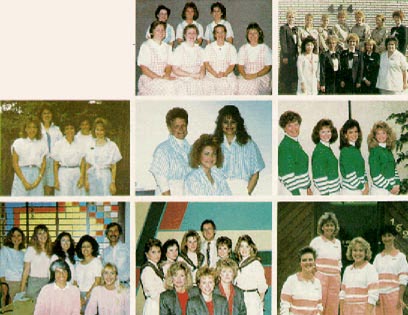THE READERS' CORNER
Topics are fiberotomy and staff uniforms.
1. How often do you recommend supracrestal fiberotomy procedures? For which teeth?
There was considerable diversity among the respondents. Only 3% reported routine use of fiberotomies; 20% reported frequent use, and 10% occasional use. The remaining 66% were evenly split between "rarely" and "never". Those clinicians using fiberotomies felt they were primarily indicated for upper and lower incisors, with occasional mention of malposed canines.
Which procedure do you prefer?
The Edwards procedure was the most frequently mentioned, but many clinicians reported no strong preference.
Who does it (you, surgeon, periodontist, GP)? Is it done before, during, or after treatment?
There was a clear majority (74%) favoring referral to a periodontist. The remaining 26% of the respondents were evenly divided between carrying out the procedures themselves and referring patients back to their general practitioners. Readers were also divided as to whether the optimum time for fiberotomy was during or after orthodontic treatment.
Has it been effective in preventing rotational relapse?
Many clinicians were ambiguous on this question. The enthusiasts reported 70-80% effectiveness, but the skeptics made comments such as "questionable" and "not effective".
Specific comments included:
2. Does your staff wear uniforms? Does the practice buy them? Do you provide a uniform allowance?
More than 85% of the offices reported that their staff members wore uniforms at work. In 70% of these cases, the practices paid for the uniforms. Most provided specific uniform allowances, with an average annual amount of $340 and a range of $40 to $1,500. The most commonly reported annual allowance was $150.
Are the uniforms traditional professional, or more reflective of current fashion? Do you favor slacks or skirts for women staff? Are the uniforms white, colored, or multicolored? How many different uniforms do you use?
The practices using uniforms overwhelmingly favored current fashion over traditional styles (Fig. 1. Four out of five offices preferred slacks to skirts for women. Fifteen percent favored white, 26% colored, and 59% multicolored uniforms. Four was by far the most common number of uniforms used, with many offices having a different uniform for each workday of the week.
What happens to the uniform when an employee leaves the practice?
More than 80% of the practices using uniforms allowed employees to keep them when they left. The others said they required employees to return their uniforms, particularly if they had only been employed for short periods of time.
Do you have special attire for holidays?
Relatively few offices--less than 20%--reported having special holiday attire. Halloween was the most popular time for different uniforms; several offices said they wore costumes and special pins. Christmas pins were also occasionally mentioned.
What are your office policies about the cleanliness of clothes and shoes? about jewelry, cosmetics, hair styles?
Offices using uniforms were remarkably consistent in their policies. They required that the uniforms be kept neat and clean, and that they be fresh each day and ironed or pressed if necessary. Shoes were to be white and kept clean and polished.
There was also a strong consensus regarding jewelry, cosmetics, and hair styles. Most practices suggested minimal, tasteful jewelry, light makeup, and hair styled so as not to interfere with patient care.
Some specific comments:
JCO wishes to thank the following contributors to this month's column:
Dr. Eldon Attaway, Irving, TX
Dr. Frank Besson, Fanwood, NJ
Drs. Karl H. Biewald, D. Michael Hackett, James M. Lipinski, and Karen L. Wedde, Cudahy, WI
Dr. William C. Binzer, Alexandria, VA
Dr. Robert Boyd, Sherman Oaks, CA
Dr. Earl Broker, Jenkintown, PA
Dr. Charles Canepa, Lorain, OH
Dr. Stephen Clark, Farmington, NM
Dr. Floyd Dickson, Muskogee, OK
Dr. J.L. Foxx, Duncanville, TX
Dr. Karl Glander, Indianapolis, IN
Drs. Philip and lan Glaser, Brentwood, NY
Dr. Gayle Glenn, Duncanville, TX
Dr. David Goodman, Wilmington, DE
Dr. Phillip Goodman, Cincinnati, OH
Dr. John C. Gorman, Marion, IN
Dr. Donald Grim, Olympia, WA
Dr. Michael Hanson, Panama City, FL
Drs. Herbert H. and Herbert M. Hughes, Alexandria, VA
Dr. Samuel Israelovitch, Montreal, Quebec
Dr. Joseph Jamison, Wilmington, NC
Dr. Kerry Kirch, Ebensburg, PA
Dr. William Klusmeier, Fort Smith, AR
Dr. Ronald Kobernick, Seminole, FL
Dr. Gul Lalwani, Voorhees Township, NJ
Dr. Herbert Lippitz, Chicago, IL
Dr. Robert Loeb, Oakland, NJ
Dr. Stephen McAuliff, Visalia, CA
Dr. Richard McBride, Lawton, OK
Dr. Gary McMullen, Citrus Heights, CA
Dr. Robert Neer, Saginaw, MI
Dr. Stanley Okun, Port Chester, NY
Dr. Joseph A. Persichetti, Holland, PA
Dr. Charles J. Rekow, Fort Thomas, KY
Dr. E.G. Righellis, Oakland, CA
Dr. Thomas Robinson, Saulte Ste. Marie, MI
Dr. Jack Rosser, San Jose, CA
Dr. John Russell, Columbus, MS
Dr. Willis Schlenker, Loma Linda, CA
Dr. Stephen Searcy, Lafayette, LA
Dr. Paul Simons, Aiken, SC
Dr. Michael Wagner, Woodinville, WA
Dr. Stephen Waldman, Brentwood, NY
Dr. James Weissman, Encino, CA
Dr. Charles Welch, Florence, SC
Dr. Timothy Winegarden, Cedar Rapids, IA



